Ideally, we'd like to create a totally personalised Passport for each individual but this can be very time-consuming. A pre-made layout, or 'template' is more efficient (if less person-centred). A template can also provide those new to Passports with not only a layout/framework, but also a few examples, prompts and suggested ideas about what to put on each page and how to present it. But PLEASE avoid turning Passport production into an 'assembly line' process using the same layout and graphics for all, and DO try to expand and personalize each as much as possible.
CALL Scotland provides a series of freely downloadable templates in Microsoft PowerPoint; the 'Basic' (all-purpose), and variants the 'Consulting Template' that emphasizes more how to find out what the child thinks (i.e. rather than telling you what he thinks) and the 'Adult Template' that may appeal more for adults.
The template consists of a title page (with space for photograph), an example Index page, and about 16 further page suggestions. (You don't have to use them all; Passports should generally not exceed 20 pages.) The pages are mainly just a title, one or two small graphics (PCS – replace with your own graphics if you don't have BoardMaker or a license for PCS symbols) and a single text box (write in the 'click to add text' box to get bulleted lines - not too many per page). Unwanted examples or prompts can just be deleted or edited. Because they are designed to be printed out, the templates are simple in style – they just have a white background and black text (though additional colour, recorded speech and any of PowerPoint's fancy animation features can be added afterwards if required, if 'live' presentation is planned at a later stage, e.g. by switch press by the child him/herself at a Review Meeting).
Lots of people like a small Passport that all fits on to one page, though obviously you can't squeeze in as much information, and it is more of a 'taster' than a full Passport. This example is in the form of a 'tri-fold' leaflet, done in Microsoft Word (these can be a real struggle to design accurately so that they fold in the right place and print the pages in the right order.....). Download here and just change the text and pictures to suit your own requirements.
Mini Passport trifold leaflet (Word, 675Kb)
Passports are often little booklets, but they do not have to be - they can be laminated single sheets, wall charts, a fan of single cards on a keyring, card case clipped to a belt, a mealtime place mat, a tri-fold leaflet etc. The precise form that a Passport takes is not important - what matters is the 'look' of the Passport (it must be attractive and easy to read) and the quality of the content (it must be accurate, up to date, and useful).
Passports generally contain information about a whole range of aspects of the person's life. However, not all Passports need to be 'Full Passports'.
Sometimes it is important to alter the focus and format of a Passport, in response to some particular situation or need, for example to:
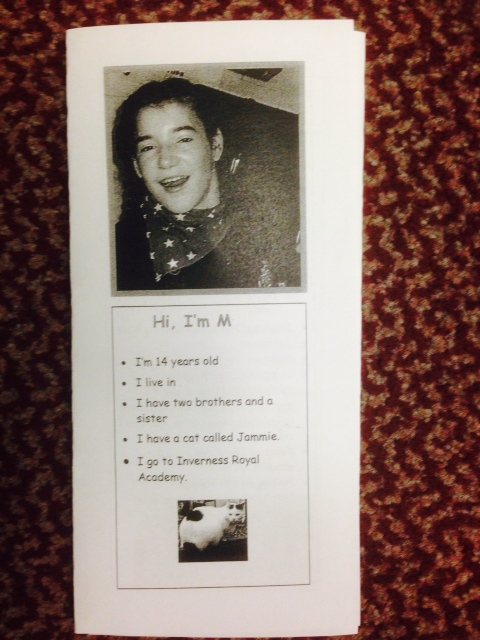
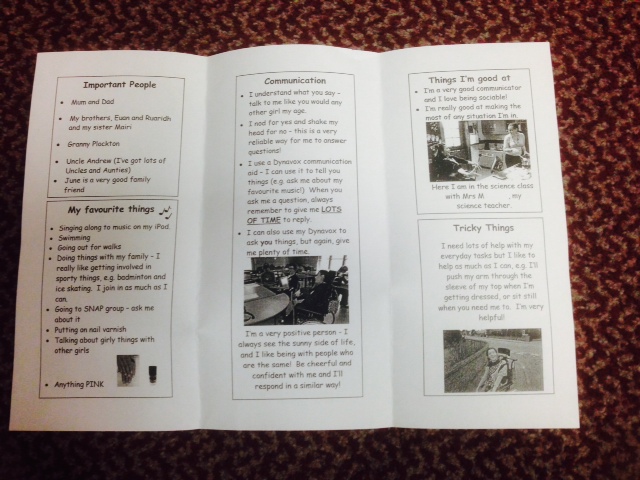
More and more, people are looking for small,quick and easy versions of Passports. These can be called 'Mini-Passports'. Various templates are available here.
This trifold leaflet is popular.
Read an article about the use of a 'Single Page Passport', or 'One Page Profile'
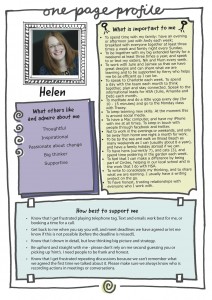
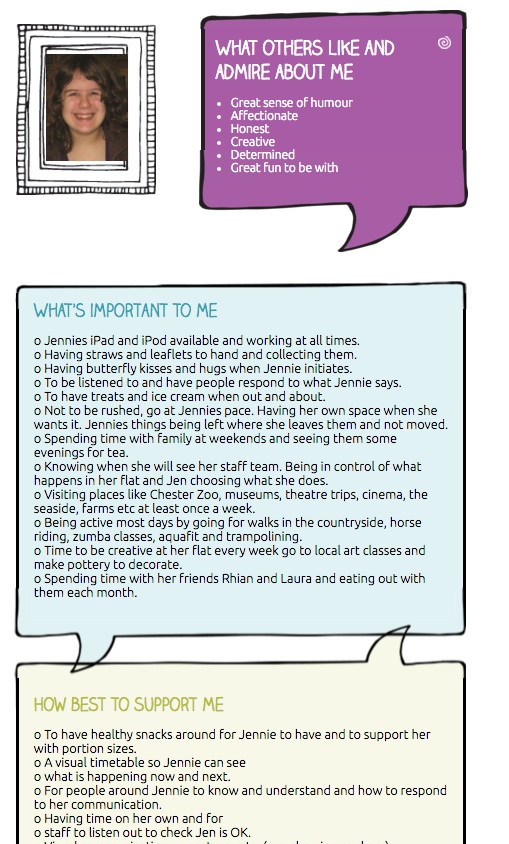
Helen Sanderson Associates have developed the use of these single page passports in Health, Social Care, and, more recently, in Education, as part of a Person Centred Planning approach.
Single Page Profiles focus on three main areas:
What other people like and admire about me; What's important to me and How best to support me. A One Page Profile template is available.
A Sheffield project on 'giving children a voice' has produced a load of templates (in Word) for fun mini one-page profiles that will really appeal to children and motivate them to partipate in creating their own Passport.
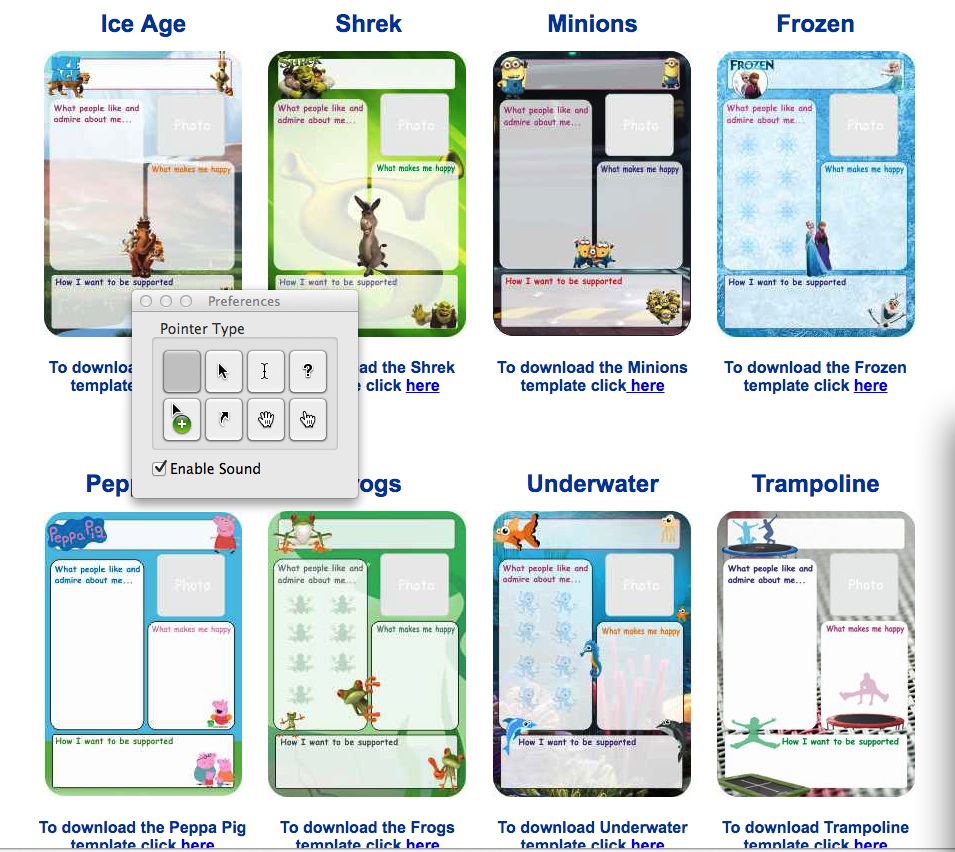
A Passport variant has been developed to help people with autism who might need hospital treatment and/or who need to communicate their needs to doctors, nurses and other healthcare professionals.
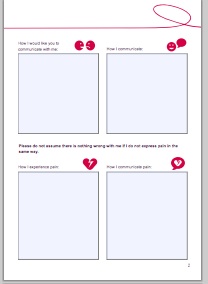
Read more about the ideas behind it, and download Guidance for its use, from the National Autistic Society website
This was developed by Baroness Angela Browning - an NAS Vice President - in collaboration with The National Autistic Society. NAS is currently setting up a research project to evaluate the use of these Hospital Passports, so the resuts of that in a year or two should make interesting reading.
Angela Crocker, a speech and language therapist in Belfast, has been pioneering Personalised Place Mats as a simple and effective way of summarising the information that can help adults with learning disabilities to positive, safe and successful mealtimes. Learn more about Personalised Placemats, view a video of a carer and download of a Placemat Template
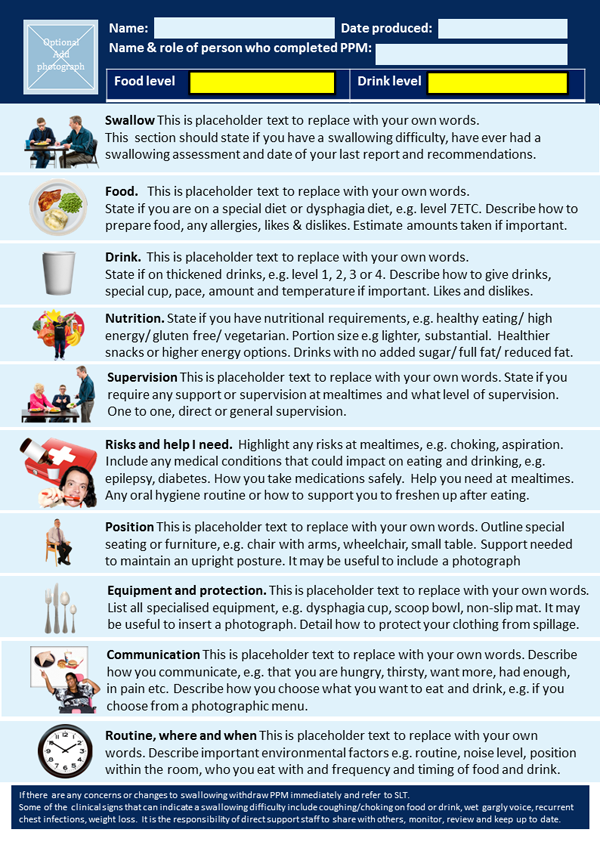
This is a form of 'Specialised Passport' or 'Single Focus Passport', in this case for eating and drinking; (could also be for such as IT access; behaviour triggers; using my vision; my medication; or topics where photos are needed to permit correct positioning and/or equipment use).
Not everyone would necessarily use the term 'Passport' for one of the above documents. But whatever 'name' is used, the principle is the same, i.e. important information distilled into a simple and easily accessible format.
You really cannot even start to make a Passport for anybody until agreement and permission has been obtained. It is ideal if the individual him/herself can agree and sign a permission, however, realistically, in many cases it may be parents of younger children or family members that will need to give their permission on behalf of the person. Because Passports are so personal and potentially powerful, it is always advisable to have clear written permission (not just a spoken 'go-ahead' in the middle of an informal chat). Below is a 'sample' letter and permission form that you can download to give you ideas about how you want to go about obtaining permission in your own setting (feel free to adapt and use this file if it helps). Please note that I am suggesting that you also always meet personally face to face at least once with parent/family/carers, rather than trying to do everything by written letters and proformas. Only then can you show that you really DO want the family to be involved as equal partners, and have open discussion and a chance for both sides to ask questions etc.
When you do meet up, it is a good idea to have an example of a nice Passport (ie. somebody else's)to show the family what you are talking about (rather than a blank sheet). If you do not have a good example to hand of another 'real' passport, you could make up a fun one about yourself or one of your own family members, as a 'demonstrator'.
It is always good practice to also try and involve the person him/herself actively in their own Passport, even if just at the level of choosing a colour or texture for their booklet cover, taking / selecting favourite photos etc. And as the pages are created and the booklet is built up, they should read through it frequently with a helper who makes it a fun activity, so that they are positively inclined to bring it out and want to show it to others.
Please adapt and edit for your own circumstances (You will only be able to edit the Microsoft Word version):
Without wishing to be too restrictive, it is important to monitor and audit both the process of creating a Passport and the end result, i.e. the Passport itself. Ideally we'd like to also evaluate outcomes and the impact of the Passport.
This set of guidelines can be used to evaluate all three, and can also be used pro-actively as a checklist to guide you step by step through the process of making a Passport, following best practice.
You may download and use this checklist and audit procedures, and perhaps adapt them for your own setting. Please feel free to do so, but please do not publish anything based on these without acknowledging this author and this " copyright document. Good Luck!
If you have developed different procedures, it would be good to 'share and compare' - please get in touch.
Microsoft Powerpoint allows for some very varied Printing options, which may be very useful to you.
We wrote a description of how to print A5 Passports on A4 paper some time ago, so you may like to try this to start you off!
(Instructions are for PowerPoint 2003 on a PC running Windows XP, so your system may vary from this, but hopefully you can follow the gist of it)